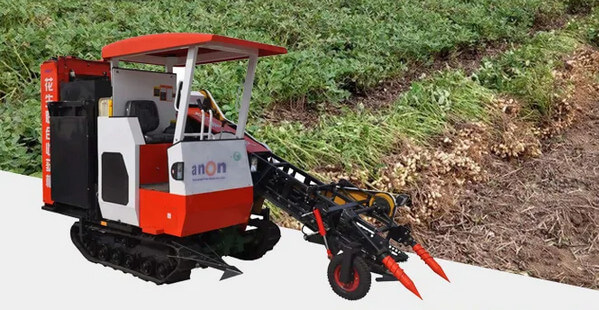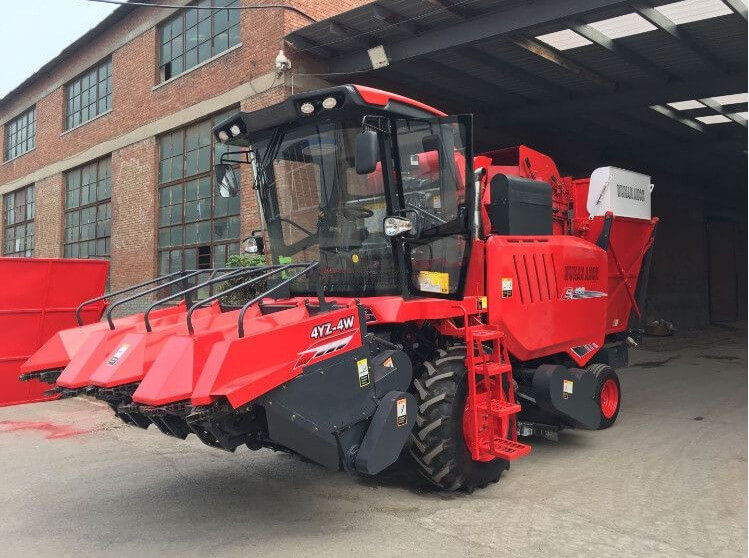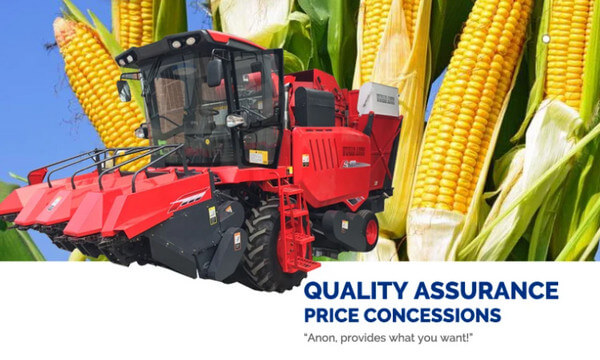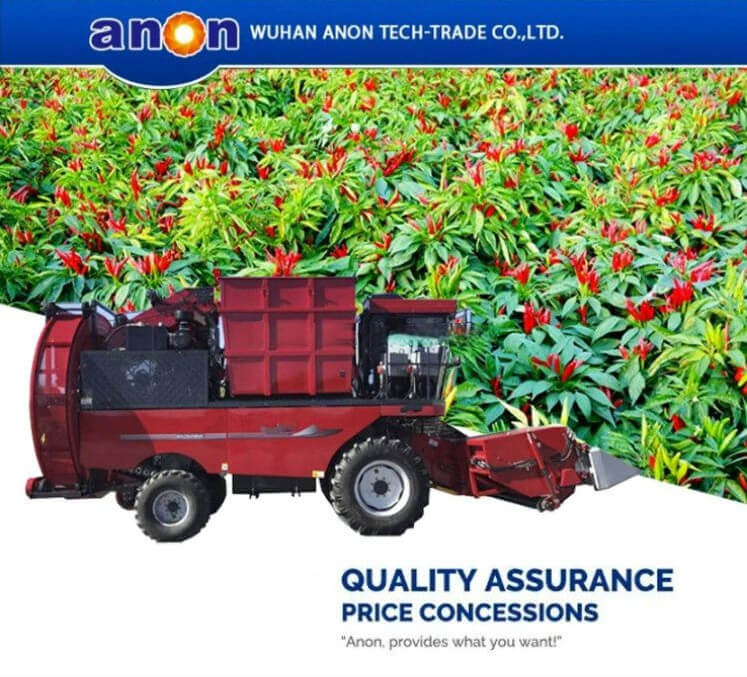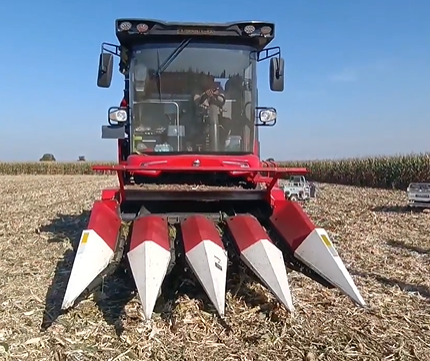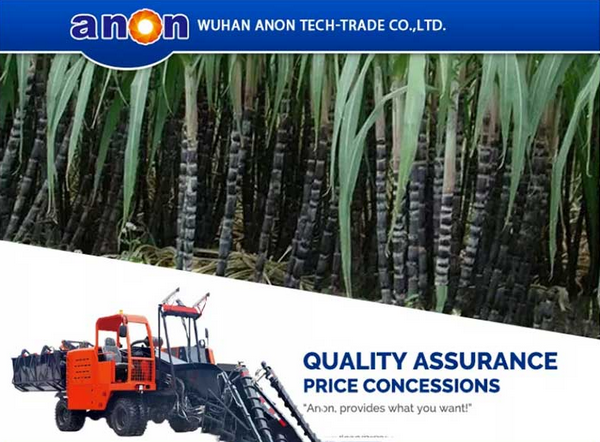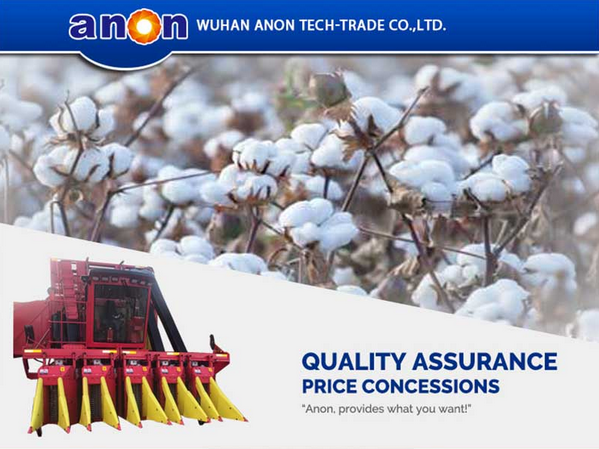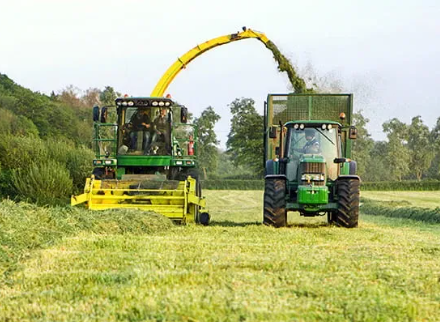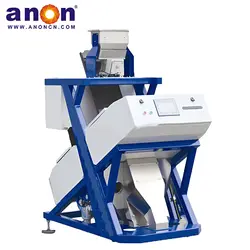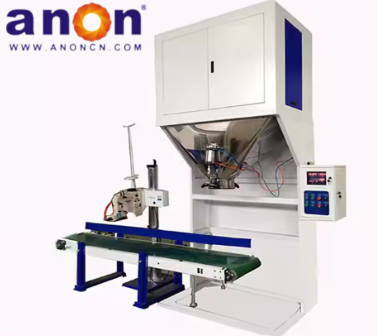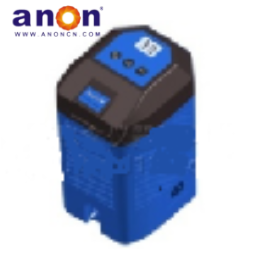Introduction
Unlike regular crops, peanuts have their fruits in the soil, which makes it difficult to harvest, and the subsequent fruit picking process is also time-consuming and labor-intensive. Traditional manual harvesting has low efficiency and significant losses during the harvesting process, resulting in high costs. Mechanized harvesting can greatly improve your efficiency, saving you time and effort, reducing costs, and increasing efficiency. This article will focus on introducing four types of peanut harvesters for you to explore more possibilities of peanut harvesting together!
Peanut Digger
A peanut digger is a type of peanut harvesting machinery that can help you dig peanut plants and roots out of the soil, and shake off the soil through vibration, transportation, and other methods. When the fruit is exposed, it will be placed on the soil surface for easy drying, manual or mechanical fruit picking. It is the earliest popular model in the peanut harvesting process, especially suitable for small and medium-sized growers. The main function of a peanut digging and harvesting machine is to completely dig out peanut plants from the soil, shake off the soil at the roots, reduce the adhesion of mud blocks, and neatly lay the peanut plants in the field to air dry, facilitating subsequent manual or mechanical fruit picking.
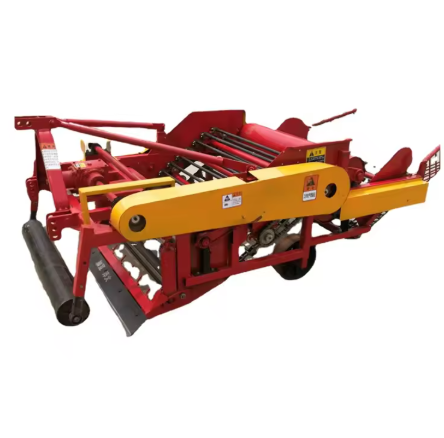
Working Principle
The tractor drives the harvester forward, and the digging shovel excavates into the soil at a certain angle, with a depth of 10-15cm. The peanut seedlings and soil are pushed onto the conveyor chain, and the chain moves backwards while being shaken by the vibrating shaft below the chain. The soil carried by the peanut seedlings is shaken off during transportation, completing the process of separating the seedlings from the soil. If any peanuts fall off during the shaking process, they will fall onto the vibrating screen below the chain. The vibrating screen moves back and forth to screen out the peanuts and store them in the tail collection basket. The peanut seedlings continue to move backwards and fall onto the guide plate, which guides them to the left side of the collected ground for the next movement of the tractor.
Components
Excavation shovel: Mainly used for cutting into soil layers and shoveling peanuts root to root.
Vibration screen and chain conveyor device: Using vibration or conveying to shake off the soil on the surface of the peanuts.
Throwing device: Lay the processed peanut plants on the ground surface.
Hanging device: Connected to the three-point suspension of the tractor.
Benefits of Peanut Digger
Low cost: The peanut excavator harvester has a simple structure and a relatively low purchase cost.
High efficiency: Its efficiency is much higher than manual labor, making it suitable for medium-sized planting.
Low peanut loss rate: The damage rate to peanuts is low, and peanuts that accidentally fall off during shaking can also fall onto the vibrating screen. After vibration screening, the soil is cleaned and sent to the collection basket at the back, greatly reducing the peanut loss rate.
Peanut Pick-up Machine
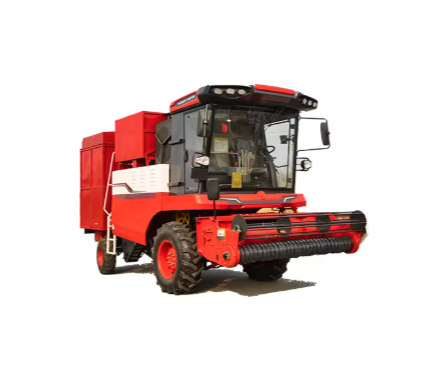
After the peanuts are dug up and dried, they need to be picked. We have two types of picking machines, one is a large automatic picking up harvester, and the other requires manual feeding.
The peanut pick-up machine is mainly used for digging and harvesting peanuts. The peanut excavator excavates the peanuts and lays them neatly in the field. After drying, the peanut picking and harvesting machine can complete picking, fruit picking, cleaning, and fruit storage in one go in the field. Peanut harvesters are mainly divided into traction-type and self-propelled peanut harvesters.
Working Principle
When the peanut pick-up machine is in operation, the picking head in front of it, which is closely attached to the ground, picks up the peanut vines lying flat in the field, and gently feeds them into the picking drum through a screw to ensure that the picking speed is synchronized with the machine’s forward speed; The teeth of the fruit picking drum work together with the concave plate to comb the peanut pods out of the vines, while avoiding damage to the pods. The separated vines are discharged through a draft separator, and the pods fall onto the vibrating screen. Finally, the vibrating screen and cleaning fan are used to screen out impurities such as soil and broken branches, and leaves from the root system. After removing the tendrils and cutting off the fruit stalks, the pods are transported by high-speed airflow to the branch fruit collection box.
Components
Pulling wheel (picking device): While the machine is moving forward, it is caught up in scattered peanut seedlings and fruits on the ground.
conveying device: Feeding spiral and toothed belt conveyors smoothly transport the seedlings to the fruit picking drum to avoid blockage.
Fruit picking system: The picking drum is used to separate peanut fruits from stems and vines, and the flexible teeth ensure thorough picking without damaging the pods.
Cleaning system: Composed of a fan and a sieve, it is used to blow away miscellaneous leaves and separate soil and stones.
Fruit collection device: Clean peanuts are collected in silos, bins, or bag openings.
Sorting device: Discharge straw, weeds, and waste materials.
Benefits of the Peanut Pick-up Machine
Efficient and low-loss: Complete the entire process at once with low loss and damage rates, and significantly higher work efficiency than manual labor.
Adaptable: It can be applied to different soil types and planting modes, such as sand and clay.
High harvest quality: After threshing and cleaning, the cleanliness of the fruit is high.
Peanut Picker
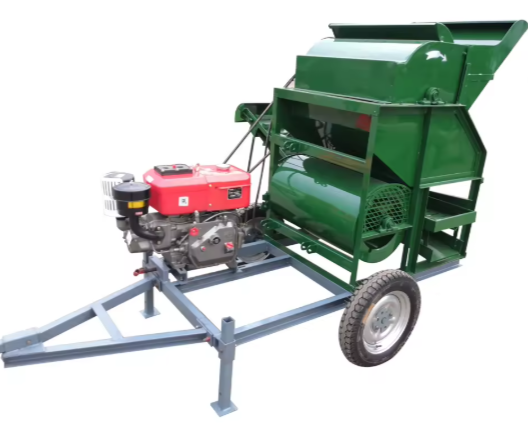
A peanut picker is an agricultural equipment that separates the fruits from the roots, stems, and branches of peanut plants. It is also used after the peanuts are excavated and dried. The difference between it and the peanut pick-up machine is that it requires manual feeding to carry out fruit picking work. Peanut picking machines are divided into fixed picking machines and traction picking machines. Traction picking machines can be used in conjunction with tractors to directly pick fruits in the field.
Working Principle
By manually feeding peanut plants into the machine, the picking drum rotates at high speed to separate the flowers and fruits from the plants through impact and friction. The separated fruits enter the cleaning system and are blown away by the fan to remove impurities. The sieve separates soil and small debris, and finally, the clean flowers and fruits are transported to the collection bin or outlet, while impurities are discharged from the discharge outlet.
Components
feeding device: Responsible for feeding peanut plants into the machine.
Fruit picking drum: Separate the fruit from the plant by striking, rubbing, and separating the rachis.
Cleaning system: Composed of a fan and a sieve, it removes impurities such as soil and blades.
conveying device: Transport peanuts to the collection bin or bagging port
Sorting device: Remove debris such as branches, leaves, straw, etc.
Benefits of Peanut Picker
The peanut picking machine can help you save labor by simply feeding the peanut vines into the machine to obtain clean peanut fruits.
Its cleaning effect is good, resulting in high-quality fruits with high cleanliness.
Flexible matching, different types of machines are suitable for users of different scales.
Key Points for Use
Before using the peanut picking machine, peanuts should be air-dried moderately to ensure moderate moisture content, and the feeding should be uniform to avoid excessive blockage or fruit breakage.
It is necessary to regularly clean the sieve, powder mill, and drum to ensure separation and cleaning effectiveness; Timely lubrication and maintenance of key components to extend machine life.
Peanut Combine Harvester
A peanut combine harvester is an agricultural machine that can dig peanuts out of the ground. Not only that, it can also do a great job of separating the dirt, peanut stems, and leaves from the peanuts. It leaves only the peanut fruits and sends the relatively clean peanuts to the fruit bin. It helps you finish the digging, picking, cleaning, transporting, and storing all at once.
Working Principle
When you open the peanut harvester to the ground full of peanuts, and adjust the plow knife, grass lifter, soil shaker, and fan, you can begin to harvest peanuts.
First of all, the grass lifter will be inserted into the ground, lifting the fallen peanut seedlings, so that the peanut seedlings are gripped by the conveyor gripping chain while exposing the peanut stem. At this time, the digging shovel, also known as the plow knife, can cut into the surface of the land, loosening the soil around the peanut seedlings.
As you drive the machine forward, the conveyor gripping chain moves the peanut seedlings backward, pulling them out. The trapped peanut seedlings will pass through the shaker, and the two shaker sticks can shake the large amount of soil on the peanut fruit by hitting the peanut seedlings. The peanut seedlings that have been initially cleaned then move to the fruit picking roller, and the fruit picking leaves rotate with the fruit picking roller to “comb” the peanut fruit. The peanut seedlings are transported further back along the conveyor gripper chain and fall out of the machine, while the peanut fruits fall on the bottom of the grid screen, which is constantly vibrating with the eccentric rocker mechanism.
The screen vibration and the airflow from the fan clean the peanuts a second time. The screen’s vibration causes the cleaner peanuts to fall onto the peanut elevator, which then transports them to the fruit bin for temporary storage.
Components
Transmission system: The engine generates power and transmits it to the various working parts of the combine to ensure the machine operates normally.
Grass holding device: Because peanuts are clustered and close to the ground, when harvesting peanuts, it is necessary to hold up the fallen peanut seedlings, which is conducive to digging and pulling up the peanut seedlings later.
Digging device: Consisting of a plow knife and an iron frame, it effectively breaks the surface of the ground and loosens the soil around the peanut plants, making it easier to pull them up.
Gripper conveyor: It consists of two sets of interlocking toothed chains, which move in opposite directions and can pinch, pull, and transport peanut plants backward.
Shaker: It consists of two shaking poles, which can shake off the large soil clods on the peanut fruit by reciprocating motion.
Fruit picker: Two fruit-picking rollers, each equipped with four evenly distributed fruit-picking leaves positioned 90 degrees apart, separate the peanut from the peanut fruit.
Cleaning and lifting system: Fans, grilles, and lifting systems primarily make up the mechanism, further removing soil and other impurities from the peanut fruit and lifting it to the fruit bin.
Fruit-collecting device: Temporarily store the cleaned peanut fruit.
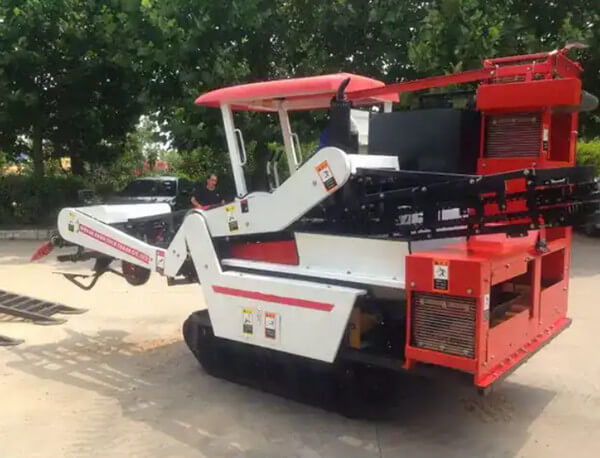
Benefits of Peanut Combine Harvester
High efficiency
Big data shows that a person can harvest only 0.0625 mu of peanuts per hour by hand. In contrast, our ANON peanut combine can harvest 2 to 3 mu per hour. That’s over 40 times more efficient, helping you complete your peanut harvest quickly.
Versatility
Labor-saving
The combine completes a variety of procedures in the harvest process in one go, offering a high level of automation. A single person can operate it, eliminating the need for tedious manual digging and screening. This greatly reduces labor requirements.
Low loss rate
Statistics show that the total field loss rate of the peanut combine is less than 5%. This includes the working crushing rate, buried fruit rate, and ground fruit rate. In comparison, the total loss rate for manual harvesting is about 8%. This means machine harvesting can help you save 2% to 3% more peanuts.
Easy to operate
How to Adjust the Peanut Combine Harvester to Reduce Losses
To minimize the total loss rate of harvested peanuts, operators must adjust the following components based on the condition of the peanuts before operating the peanut harvester.
Grain lifter
To lift the peanut seedlings successfully, you first need to adjust the height of the grass holder. Under normal conditions, it’s best to insert the tip of the grass holder about one centimeter into the ground.
Digger blade
The shovel also needs to be adjusted according to the actual situation. You can adjust the plow blade by twisting the screw so that the plow blade is 18 to 22 cm below the chain.
Soil cleaning mechanism
The smaller the gap between the two shaking rods, the better the shaking effect. However, if the gap is too small or too large, it may shake the peanuts off. Therefore, the gap should be adjusted to a reasonable range.
Air blower
The fan is a key part of the cleaning system. It needs enough wind to blow away large, light impurities. You can adjust the air volume by tweaking the fan’s wind baffle. Also, make sure the fan outlet blows upward to improve the air-cleaning effect.
Conclusion
After reading the above article, you must now have your own understanding of the peanut harvester. If you have any questions, please contact us at ANON. As a professional agricultural machinery expert, we will be happy to answer your questions and provide you with a professional machine choice!
FAQ
How does soil type affect my choice of peanut harvester?
Different soil types affect the machine’s performance. Machines with adjustable digging parts and a flexible design will perform better in various soil conditions, ensuring you harvest efficiently.


